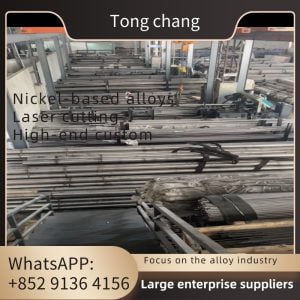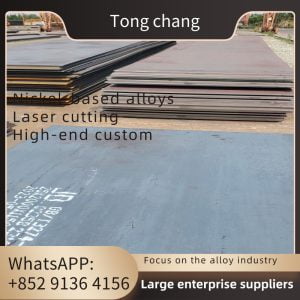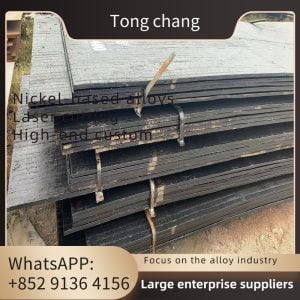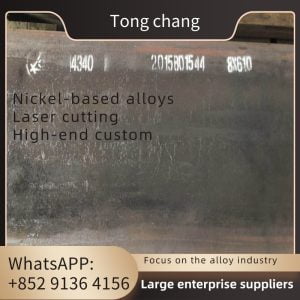| Product Name: | Embedded G-type Fin Tube | Type: | G Type |
|---|---|---|---|
| Tube Standard: | ASME SB163 | Tube Material: | MONEL 400 (UNS N04400) |
| Tube OD: | 20mm To 219mm OD Max. | Fin Thickness: | 0.8mm To 4mm |
| Tube Length: | As Request | Fin Material: | Alumininum 1060 |
| Fin Height: | 0.25′ (6.35mm) To 1.5′(38mm) | Application: | HEAT EXCHANGE, BOILER, Etc. |
| High Light: | Embedded Finn Tube, ASME SB163 Finn Tube, Finned Tube ASME SB163 | ||
NICKEL ALLOY FINNED TUBE EMBEDDED G-FIN TYPE SB163 MONEL 400
Advantage of Fin Tube
By not using a finned tube the outside surface area is not significantly greater than the inside surface area. Because of that, the fluid with the lowest heat transfer coefficient will dictate the overall heat transfer rate. When the heat transfer coefficient of the fluid inside the tube is several times larger than that of the fluid outside the tube the overall heat transfer rate can be greatly improved by increasing the outside surface area of the tube.
For applications that involve the transfer of heat from a hot fluid to a colder fluid through a tube wall, fin tubes are used. Usually, for an air heat exchanger, where one of the fluids is air or some other gas, the air side heat transfer coefficient will be much lower, so additional heat transfer surface area or a fin tube exchanger is very useful. The overall pattern flow of a finned tube exchanger is often crossflow, however, it can also be parallel flow or counterflow.
Fins are used to increase the effective surface area of heat exchanger tubing. Furthermore, finned tubes are used when the heat transfer coefficient on the outside of the tubes is appreciably lower than that on the inside. In other words, heat transferred from liquid to gas, vapor to gas, such as steam to air heat exchanger, and thermic fluid to air heat exchanger.
SB 163 N04400 Nickel based ASME SB 163 UNS N04400 pipe is known for its resistant to seawater and steam at high temperaturesas.
Embedded G-Type Finned Tube Features:
- 1. Compact design
- 2. High-performance
- 3. Easy installation
- 4. Less space required
- 5. Less cabling
- 6. Optimized surface
- 7. Finest technology used
- 8. Average corrosion protection
- 9. Less energy consumption
- 10. Increased reliability
- 11. Low maintenance
- 12. High mechanical resistance
Processes of G-type Finned Tube
In G-type finned tubes, the fins are prepared by embedding the metal strip into a groove. The latter is formed on a base tube. Placing the fin on it, back-filling is done – resulting in strong attachment of the fins to the base tubes. Hence, the name G-Fin Tubes has come up. The three processes mentioned above are carried out simultaneously. Maximum heat transfer is expected out of the g-fin tubes as the fins are strongly attached to the base tube.
The G-type finned tubes usually work at high temperature (with around 400 degree Celsius) applications. Made of copper, carbon, or aluminium, these fins have comparatively less resistance towards atmospheric corrosion. On the other hand, mechanical resistance is acceptable. Stainless steel and carbon steel fin materials are also used, but particular processing and tooling of the steel fin strips are necessary. Air coolers, radiators, etc use the g-fin tubes.
Technical Details/Base Tube Details
- Tube Diameter : 20 mm OD Min to 219 mm OD Max.
- Tube Thickness : Minimum 2 mm up to 16mm
- Tube Material : Carbon Steel, Stainless Steel, Alloy Steel, Corten steel, duplex Steel, Super Duplex Steel, Inconel, High Chrome High Nickle & Incolloy, CK 20 material and some other material.
About Monel 400 Base Tube
Monel belongs to a group of nickel alloys. It is produced with high concentrations of copper and chromium in their chemical composition. These tubes are designed to suffice in corrosion stress-induced environments. They don’t easily dissociate or deform under any temperatures. The SB 163 N04400 grade is designed with superior strength and excellent mechanical properties. They possess a minimum tensile strength of 550Mpa and a minimum yield strength of 240Mpa. The products from this grade can be easily elongated by 40%.
Monel 400 is a nickel-copper alloy (about 67% Ni – 23% Cu) that is resistant to sea water and steam at high temperatures as well as to salt and caustic solutions. Alloy 400 is a solid solution alloy that can only be hardened by cold working. This nickel alloy exhibits characteristics like good corrosion resistance, good weldability and high strength. A low corrosion rate in rapidly flowing brackish or seawater combined with excellent resistance to stress-corrosion cracking in most freshwaters, and its resistance to a variety of corrosive conditions led to its wide use in marine applications and other non-oxidizing chloride solutions.
Chemical Composition
| Grade | C | Mn | Si | S | Cu | Fe | Ni | Cr |
| Monel 400 | 0.30 max | 2.00 max | 0.50 max | 0.24max | 28.0-34.0 | 2.50 max | 63.00 min | – |
Mechanical Properties
| Element | Density | Melting Point | Tensile Strength | Yield Strength (0.2%Offset) | Elongation |
| Monel 400 | 8.8 g/cm3 | 1350 °C (2460 °F) | Psi – 80,000 , MPa – 550 | Psi – 35,000 , MPa – 240 | 40 % |
Physical Properties
| Properties | Metric | Imperial |
|---|---|---|
| Density | 8.8 gm/cm3 | 0.318 lb/in3 |
Industries of G-Type Finned Tubes
- Rubber plants
- Power plants
- Petroleum industries
- Chemical industries
- Marine engineering.
- Chemical and hydrocarbon processing equipment.
- Gasoline and freshwater tanks.
- Crude petroleum stills.
- De-aerating heaters.
- Boiler feed water heaters and other heat exchangers.
- Industrial heat exchangers.
- Chlorinated solvents.
- Crude oil distillation towers.








